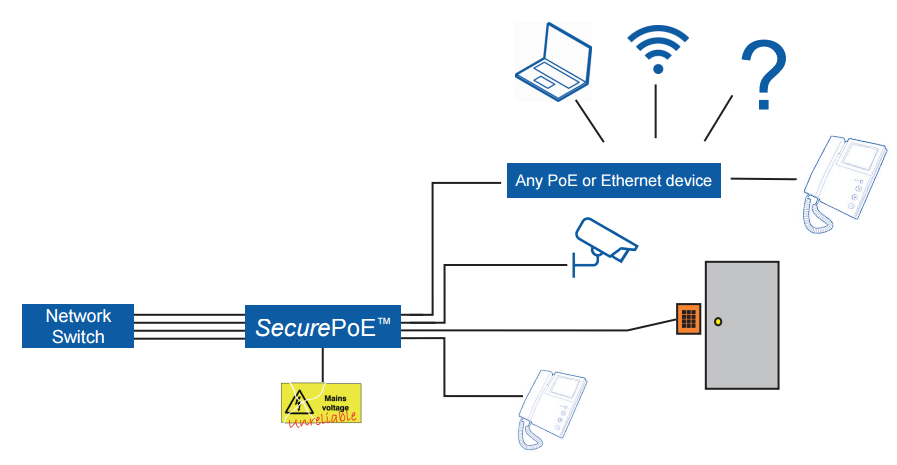Power considerations
Security system components have varied power needs: a supply of direct mains, specified DC or AC low-voltage, or PoE (Power over Ethernet). Often systems will use a mixture of supply voltages due to the requirements of individual components. Power distribution decisions should be based on key factors such as reliability, continuity, accessibility, compliance, physical security and cost. Many system devices are capable of functioning with more than one type of supply. Surveillance cameras might accept a low-voltage AC or DC input as well as PoE power.
Security systems consist of pathways carrying information between system components and pathways distributing power. With networked systems these two types of interconnecting path can be located separately, follow a similar route or be physically combined. System power can be planned much like a simple data network, with the incoming power branching out, via PSUs and power storage devices, to the various components. A good design will minimise power transmission bottlenecks, reduce single points of failure and consecutive points of potential failure within each path.

Mains back-up generators and UPS systems may be pre-existing at a location or specified for installation. These can be helpful but should be scrutinised with regard to acceptability, including the effect of a unit failure.
IP security devices such as surveillance cameras tend to reboot
following a power interruption, resulting in a loss of coverage during the reboot period, which can last anything up to 90 seconds. The use of a dedicated maintained power supply local to devices ensures seamless operation. The prevention of device reboot downtime makes a powerful case for the use of battery-maintained power supplies in all security applications, as does the continuous provision of functions like edge storage, door entry and call-point access, regardless of mains and network state.
It is more reliable to use power supplies that are separate from network infrastructure. Separation of power provision removes single points of failure, reducing both the likelihood and the magnitude of failures. Good dedicated power units normally have higher life expectancies than switching equipment.
All PSUs have a conversion-efficiency loss which is shed as heat, potentially affecting other equipment. Network devices with integrated power outputs may have a power budget
, limiting the defined output power to a specified total figure, rather than providing full capability to all outputs.
This allows the possibility of load devices being connected with insufficient power available. With some supply products it is possible to overload the integrated power supply, resulting in a shut down of all outputs until the overload is removed. As some common devices have variable power consumption, it is a risk that these will appear to function normally until loads demand higher power levels.
While convenient, the use of integrated power outputs for critical operations is questionable. The specification of separate PSUs will improve system reliability.
Given sensibly specified power supplying equipment, bottlenecks in power distribution paths are a function of voltage supplied, power demanded and wire conductor size used. These bottlenecks manifest as resistive 'volt drop'. Conductors have an inherent resistance at a given temperature and the degree of volt drop is inversely proportional to the voltage supplied. Ohm's law dictates that for any known conductor and power conducted, a doubling of supply voltage will half the current, hence also halving the voltage drop. Importantly, the resulting transmission power loss is actually quartered as a result of doubling the voltage, due to the halving of the current conducted and the resultant halving of the volt drop. Subsequently it is preferable to use available higher voltages until within the area of load devices, which commonly means using mains power. At the load device area, a secure PSU or PoE midspan can be sited, including battery back-up if required.
The IEEE standard for PoE devices ensures power losses will be acceptable within a 100 meter span. Non-compliant PoE devices are an unknown and a potential hazard. To reduce points of failure in a power path it is necessary to minimise the number of power conversion stages. Supplying mains voltage to the load area (or where not possible the next highest available voltage) then using one or more low-voltage power supplies keeps the path as simple as possible. For normal practical purposes and as a requirement for PoE supplies, installation of the low-voltage PSUs should be within 100 meters of the load devices. If necessary, these can be sited alongside network apparatus such as edge switches and media converters, as well as being status monitored dependent on system requirement.
Power repeaters designed for consecutive placement in a power path can save up-front cost but give multiple failure points in the path. They are also inefficient, having a conversion efficiency loss at every stage.
The applicable standard defining the requirements of all compliant PoE devices is IEEE802.3:2012. This incorporates the earlier standard amendments 802.3af (2003) and 802.3at (2009). The af
and at
references continue to be seen. Two device power categories exist: up to 15.4W (af
) and up to 30W (at
or PoE+). It is sensible to specify the 30W supplies as this allows the connection of any PoE standard compliant device.
The choice of conventional versus PoE power is often debated. Both methods are valid. Whichever is used, the consideration of minimising losses, separating power, removing failure points and spreading risk between multiple power supply units will enable the design of reliable systems.
